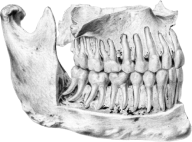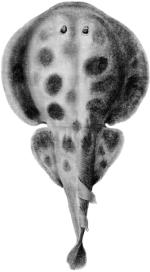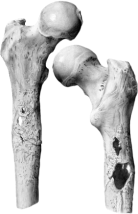
Corrosion cast of the liver after injection of the portal vein (light blue), hepatic artery (red), biliary tract (yellow) and inferior vena cava (dark blue).
Anatomy and Pathology workshop
As part of the Hunterian Museum school programme, the Royal College of Surgeons of England is developing a new workshop in the Anatomy and Pathology Museum, usually only open to medical/healthcare professionals or trainees.
This includes small groups of students observing specimens with a medical volunteer to discuss and study curriculum based themes.
This session is intended to encourage students to study real specimens and make observations.
Based on the English curriculum syllabus of A Level Biology, International Baccalaureate - Biology, BTEC/ T Level Health and Social Care, Physiology and Science courses - we have selected a number of themes to study during the workshop.
Groups of maximum 5 students will be studying specimens with a medical volunteer to observe and discuss anatomy and pathology inside the body.
The workshop can be led by the museum staff or tailored by you to meet specific teaching and learning needs.
In the Library, students will have a chance to observe :
- Anatomical Drawings
- Illustrations of Disease, disorders, organs, cells and tissue
- Research from Pasteur, Koch and Rudolph Virchow on microscopy, public health and sanitation
Further reading suggested:
- Blog written by an archivist on John Snow here: https://www.rcseng.ac.uk/library-and-publications/library/blog/mapping-disease-john-snow-and-cholera/
Further information:
This workshop is designed for Year 13 A Level Biology, International Baccalaureate - Biology, |Level 3 BTEC/ T Level Health and Social Care, Physiology and Science courses only.
This workshop has a maximum capacity of 15 students. The ratio of adults to pupils depends on students’ age:
- Age 17-18: 1 adult to 15 pupils
The minimum group size is 6 people, including 1 adult.
75 min workshop only
120 min workshop and Library & Archives visit
190 min Hunterian Museum, workshop and Library & Archives visit
There is a 15 minute buffer for arrival time, toilet break and walking to the workshop room.
FULLY BOOKED until end 2025.
More dates available on Thursdays from 15 January to 26 March 2026.
£125
Currently 50% discount is offered
Royal College of Surgeons of England, 38-43 Lincoln's Inn Fields, London. WC2A 3PE
Curriculum Themes
AQA A-level Biology
3.3 Organisms exchange substances with their environment 3.3.4 Mass transport in animals |
|
Edexcel A-level Biology
Unit 1: Molecules, Diet, Transport and Health Topic 1 – Molecules, Transport and Health |
|
OCR A-level Biology A
Module 3: Exchange and transport 3.1.2 Transport in animals |
|
Eduqas A-level Biology
Component 3: Requirements for Life 2. Adaptations for transport |
|
BTEC Level 3 National in Health and Social Care (Extended Certificate)
Unit 2: Human biology and health B1 The cardiovascular system |
| |
Unit 2: Human biology and health C1 The main disorders of the body systems | Coronary heart disease:
|
BTEC Level 3 National in Medical Science (Extended Certificate)
Unit 1: Principles of human physiology, anatomy and pathology D1 The cardiovascular system |
|
International Baccalaureate (IB) Biology
| B3.2 Transport |
|
T Level Technical Qualification in Health
| How lifestyle choices impact good health and wellbeing:
|
AQA A-level Biology
3.3 Organisms exchange substances with their environment 3.3.2 Gas Exchange |
| |
|
|
Edexcel A-level Biology
Unit 1: Molecules, Diet, Transport and Health Topic 2 – Membranes, Proteins, DNA and Gene Expression |
|
OCR A-level Biology A
Module 3: Exchange and transport 3.1 Exchange and transport |
|
Eduqas A-level Biology
Component 3: Requirements for Life 1. Adaptations for gas exchange 2. Adaptations |
| |
| Option A: Immunology and Disease |
|
BTEC Level 3 National in Health and Social Care (Extended Certificate)
Unit 2: Human biology and health B2 The respiratory system |
| |
Unit 2: Human biology and health C1 The main disorders of the body systems |
|
BTEC Level 3 National in Medical Science (Extended Certificate)
Unit 1: Principles of human physiology, anatomy and pathology D2 The respiratory system |
|
Unit 4: Diseases, disorders, treatments and therapies B1 Physiological diseases and disorders |
|
International Baccalaureate (IB) Biology
| B3.1 Gas exchange |
|
T Level Technical Qualification in Health
| A9: Health and wellbeing |
|
| B2: Further science concepts in health |
|
AQA A-level Biology
3.3 Organisms exchange substances with their environment 3.3.3 Digestion and absorption |
|
Edexcel A-level Biology
Unit 1: Molecules, Diet, Transport and Health Topic 2 – Membranes, Proteins, DNA and Gene Expression |
|
Eduqas A-level Biology
Component 3: Requirements for Life 3. Adaptations for nutrition |
|
BTEC Level 3 National in Health and Social Care (Extended Certificate)
|
| |
Unit 2: Human biology and health C1 The main disorders of the body systems |
|
BTEC Level 3 National in Medical Science (Extended Certificate)
Unit 1: Principles of human physiology, anatomy and pathology E2 The digestive system |
|
T Level Technical Qualification in Health
| A9: Health and wellbeing | How lifestyle choices impact good health and wellbeing: consumption of alcohol – weakens immune system, increasing risk of infections |
| B2: Further science concepts in health |
|
AQA A-level Biology
3.3 Organisms exchange substances with their environment 3.3.4 Mass transport in animals |
|
3.6.4 Homeostasis is the maintenance of a stable internal environment (A-level only) 3.6.4.2 Control of blood glucose concentration |
|
Edexcel A-level Biology
Unit 5: Respiration, Internal Environment, Coordination and Gene Technology Topic 7 – Respiration, Muscles and the Internal Environment |
|
OCR A-level Biology A
|
Module 5: Communication, homeostasis and energy 5.1.2 Excretion as an example of homeostatic control |
|
Module 5: Communication, homeostasis and energy 5.1.4 Hormonal communication |
|
Eduqas A-level Biology
Component 3: Requirements for Life 4. Homeostasis and the kidney |
|
BTEC Level 3 National in Health and Social Care (Extended Certificate)
Unit 2: Human biology and health B4 The endocrine and renal systems |
|
Unit 2: Human biology and health C1 The main disorders of the body systems |
|
BTEC Level 3 National in Medical Science (Extended Certificate)
Unit 1: Principles of human physiology, anatomy and pathology E1 The renal system |
|
International Baccalaureate (IB) Biology
| D3.3 Homeostasis | Role of the kidney in osmoregulation and excretion: understand the distinction between excretion and osmoregulation |
T Level Technical Qualification in Health
| A9: Health and wellbeing |
|
| B2: Further science concepts in health |
|
AQA A-level Biology
3.3 Organisms exchange substances with their environment 3.3.4 Mass transport in animals |
|
Edexcel A-level Biology
Unit 1: Molecules, Diet, Transport and Health Topic 1 – Molecules, Transport and Health |
|
OCR A-level Biology A
Module 3: Exchange and transport 3.1.2 Transport in animals |
|
Eduqas A-level Biology
Component 3: Requirements for Life 2. Adaptations for transport |
|
BTEC Level 3 National in Health and Social Care (Extended Certificate)
Unit 2: Human biology and health B1 The cardiovascular system |
|
BTEC Level 3 National in Medical Science (Extended Certificate)
Unit 1: Principles of human physiology, anatomy and pathology D1.4 Structure and functions of blood vessels |
|
International Baccalaureate (IB) Biology
| B3.2 Transport |
|
T Level Technical Qualification in Health
| B2: Further science concepts in health |
|
Edexcel A-level Biology
Unit 5: Respiration, Internal Environment, Coordination and Gene Technology Topic 7 – Respiration, Muscles and the Internal Environment |
|
Eduqas A-level Biology
| Option B: Human Musculoskeletal Anatomy |
|
BTEC Level 3 National in Health and Social Care (Extended Certificate)
Unit 2: Human biology and health B5 The musculoskeletal system | The role of the structures of the musculoskeletal system in providing support and structure to the body and enabling movement: bone |
BTEC Level 3 National in Medical Science (Extended Certificate)
Unit 1: Principles of human physiology, anatomy and pathology C1 The skeleton |
|
Unit 1: Principles of human physiology, anatomy and pathology C3 Disorders of the musculoskeletal system |
|
International Baccalaureate (IB) Biology
| B3.3 Muscle and motility |
|
T Level Technical Qualification in Health
| A9: Health and wellbeing |
|
| B2: Further science concepts in health |
|
Edexcel A-level Biology
|
Unit 5: Respiration, Internal Environment, Coordination and Gene Technology Topic 8 – Coordination, Response and Gene Technology |
|
OCR A-level Biology A
Module 5: Communication, homeostasis and energy 5.1.5 Plant and animal responses |
|
Eduqas A-level Biology
| Option C: Neurobiology and Behaviour |
|
BTEC Level 3 National in Health and Social Care (Extended Certificate)
Unit 2: Human biology and health B3 The nervous system |
|
Unit 2: Human biology and health C1 The main disorders of the body systems |
|
BTEC Level 3 National in Medical Science (Extended Certificate)
Unit 1: Principles of human physiology, anatomy and pathology B1 The nervous system |
|
International Baccalaureate (IB) Biology
| C3.1 Integration of body systems |
|
T Level Technical Qualification in Health
| A9: Health and wellbeing |
|
| B2: Further science concepts in health |
|
Curriculum Links
PDF curricula links (pdf, 364.433 KB)
Please select up to three curriculum based themes listed above to focus on. If you may wish to explore a specific theme not listed here or focus on a particular specimen of interest please contact [email protected].
Please email with your preferred date and preferred time.


